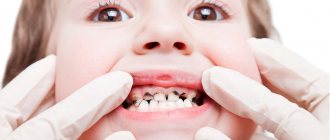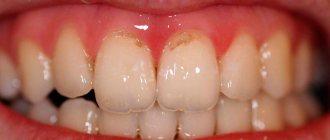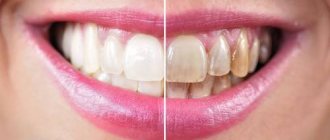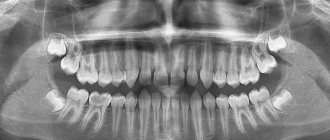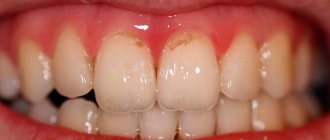Main reasons
Why can one or more teeth turn blue? There may be several reasons for this; sometimes there is nothing dangerous to health in this process, and sometimes this is a reason to urgently seek advice from a dentist. A change in shade is possible due to poor quality nutrition or adherence to a strict diet. This can also happen if you eat a lot of fresh berries, such as blueberries, blueberries or blackberries.
Newly installed fillings may differ in color from natural tissues. A pulpless, that is, dead tooth can also change its color. This is explained by the fact that when the pulp is removed, nutrients stop flowing to the tissues.
If a seemingly healthy tooth begins to turn blue, this may indicate that there are problems with the root system. This is usually preceded by serious dental diseases. In addition, the cause of blue enamel may lie in the patient’s body; this phenomenon may be caused by the presence of chronic diseases or problems with the digestive system. Another common reason is the use of low-quality water with high levels of iron.
Internal color change
It may be associated with the use of certain medications, the condition of the dentin and pulp, and the characteristics of endodontic treatment.
Tetracycline teeth. A condition in which the enamel darkens and yellow or brown spots appear on its surface. Associated with the accumulation of tetracycline in tissues when taking drugs containing it in large dosages. May occur in children if the mother took medications containing tetracycline during pregnancy. In severe forms, it provokes the destruction of hard tissues and can lead to tooth loss. During treatment, restoration of the affected crowns is performed.
Fluorosis. Violation of mineralization, changes in the structure and structure of the hard tissues of the crown due to excessive fluoride consumption. The disease is common in areas with fluoridated drinking water and can occur as a complication of improperly performed or too frequent fluoridation in dentistry. With fluorosis, the color of the enamel changes, either matte white, or yellow, brown, or black areas appear.
After dental treatment. If materials for filling and restoration are selected or prepared incorrectly, their structure will be disrupted and they will absorb dyes faster than enamel. Because of this, colored spots may appear on the surface of restored, treated teeth. Another possible problem is the use of metal structures that are visible through the enamel (veneer crown bases, inlays, implant abutments). The color of the tooth may change if, during endodontic treatment, nitrates, canal filling materials, oils, iodine compounds come into contact with the dentinal tubules and penetrate into them.
Complication of a systemic disease. Usually these are rare childhood or genetic diseases that can affect the formation of hard tissues and change their structure. Among them are hemolytic jaundice, fetal erythroblastosis, porphyria. Metabolic disorders or some endocrine diseases can provoke darkening of the enamel, changes in its structure, and loss of gloss.
Age-related changes. Enamel darkens with age and may lose its gloss, shine, and look dull. Pigmentation is enhanced by tooth wear. It will be more pronounced if a person has been drinking coffee or tea in large quantities for many years or smoking. Due to age-related thinning of the enamel, the formation of secondary dentin causes it to darken, which changes the appearance of the teeth.
Hypoplasia. It looks like white spots located on the same teeth of the upper and lower jaws. The enamel structure remains solid, it does not lose its gloss, and such areas are not painted. They can appear due to improper, too frequent or aggressive bleaching.
Complication of pulpitis or trauma. After the pulp is removed, the crown may become dull and gray. With pulp necrosis and nerve damage, the same, but more intense changes are possible.
The structure of the crown or enamel. The thickness of the enamel layer, its density, and natural shade are individual. With a small thickness of this layer, the cutting edges of the teeth may look grayish and translucent. At high density, the natural tone will be stable: the crowns will be less stained when consuming coloring drinks and foods, but it will also be more difficult to whiten them.
Treatment of blue teeth
If during diagnostics it is determined that the cause of blueness of all teeth is the use of special products, the dentist or hygienist may prescribe a professional cleaning of the oral cavity. Quite often the patient requires enamel polishing; this allows for the best results.
If after such manipulations the blue discoloration does not disappear, you can try other methods.
First of all, the doctor should send the person for an X-ray examination of the jaw, this will make it possible to make a correct diagnosis, as a result of which the treatment will be as effective as possible. It may also be necessary to remove previously installed fillings and caries-infected hard tissues. If necessary, treatment of the annals and root system of the tooth will be prescribed.
There are several methods to restore the original whiteness of your teeth. One of the most common options is the installation of a composite filling, that is, direct artistic restoration of a row. A more expensive procedure is the production of an artificial crown or special onlays - veneers (indirect restoration).
Why does sensitivity increase?
In some cases, after installation, Patients complain of a greatly increased sensitivity, causing pain when eating or talking. In most of these cases, pain intensifies two weeks after the restoration procedure. The reason is too much enamel layer removed during preparation. This increases tissue sensitivity and causes an enhanced reaction.
To resolve the issue, the doctor may prescribe the following measures:
- tissue fluoridation procedures are performed within three to five days;
- A varnish is applied to the surface to protect against excessive sensitivity; for better hardening of this composition, it is additionally polymerized with lamp light;
- office cleaning from accumulations of plaque and stone;
- removal of the nerve after hiding the tooth (in the presence of severe pain and ineffectiveness of previously taken measures).
The patient must understand that the installation of veneers with preliminary preparation is an irreversible process. The teeth will no longer return to their previous condition; the enamel is completely removed, which means that the linings will have to be replaced after the end of their service life. The doctor should also explain that increased sensitivity is a normal reaction; only severe, constant pain is considered a complication.
The situation gets worse if the plate is damaged, has chips and signs of deformation. Dentin remains under the overlay without additional protection in the form of an enamel layer, that is, every touch will be painful. In this case, the veneers must be changed; if the pain persists, the nerve is removed.
Operational terms
The service life of the linings depends on the following nuances:
- type of design, materials of manufacture;
- thickness, method of fastening to the surface;
- dental condition;
- Patient compliance with oral care recommendations.
The most durable are ceramic plates. They can withstand significant loads, look natural and do not require frequent replacement. The service life of such plates is eight to ten years; if the rules of care are followed, they can last longer. Zirconium models are stronger and will last a couple of years longer. Composite straight overlays are the most short-lived. On average, correction will be required within five years after installation.
Recommendations for the Patient
After installing the pads, the patient is given recommendations on how to care for them:
- daily cleaning using non-abrasive pastes and brushes with medium or soft bristles;
- the use of irrigators and rinses to remove food debris;
- Regular visits to the dentist for in-office plaque cleaning and preventive examinations.
In addition, loads should be distributed correctly and loads on the frontal zone should be avoided. It is recommended to give up bad habits and change your diet, eliminating coloring foods from it. For those who play sports, it is necessary to use protective mouthguards. Such simple rules will help maintain a healthy smile and the integrity of the installed veneers for a longer period.
Blue gums
Another common phenomenon, especially in young children, is blue discoloration of the gum tissue. It often occurs during the eruption of the first, baby teeth. During this process, inevitable damage occurs to tissues penetrated by a huge number of blood vessels of different sizes. As a result, blood can enter the soft tissue, leading to the formation of a small hematoma.
That is why, if a baby has a hematoma or bruise in a place where a new tooth is expected to appear soon, there is no cause for concern. However, in all other cases it is recommended to show the child to the dentist. The cause of blueness may be an inflammatory process. It is usually preceded by diseases such as gingivitis or stomatitis.
It is important that such complications usually occur in children with weakened immune systems. Also, the health of teeth and gums is greatly influenced by compliance with the rules of daily care. Due to the abundant accumulation of plaque and stone, most ailments appear; this is especially dangerous at an early age, when the enamel is not yet strong enough.
Associated symptoms
Gums can turn blue not only in the youngest patients, but also in adults. As a rule, this pathology is accompanied by many other symptoms. Most often, a person experiences noticeable pain, especially with accidental contact with tissue or with solid food, and the gums may swell and bleed.
If the cause of darkening or the appearance of age spots lies in the inflammatory process, the following symptoms can be diagnosed: severe fever and chills, itching and burning, the appearance of blood or purulent discharge, and others. In this case, immediate treatment is required in a dental clinic; traditional methods will not be effective.
If the cause of darkening of the gum or tooth is the incorrect installation of a prosthesis or crown, the patient may complain of pain even at rest, as well as slight tingling and numbness of the tissue (a sensation similar to what happens after the end of anesthesia).
previous post
How is a general examination at the dentist performed?
next entry
The best specialists from France
François Najjar: French Dental Clinic.
Chief physician, founder of FDC
Since 2004, the doors of the first exclusive French Dental Clinic in Russia have been opened for everyone who wants to have an appointment with famous specialists from Paris, Nice, Cannes, Sophia Antipolis, Lyon, Lille.
Specialists from all areas of dentistry were invited from different parts of France in order to undergo the most stringent selection. The choice fell on professionals with extensive experience of successful work and excellent recommendations.
— French Dental Clinic team
Frank Ajege
Periodontist-implantologist
Experience in surgical dentistry since 1987. Has a private clinic in Nice (France).
Michel Cassagne
Orthodontist
with over 30 years of experience in dentistry. Has a clinic in Paris, specializing in aesthetic orthodontics.
Didier Saada
Dentist
Experience in dentistry since 1988. Graduated from the Faculty of Surgical Dentistry at the Medical University in Marseille.


